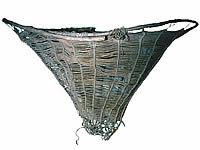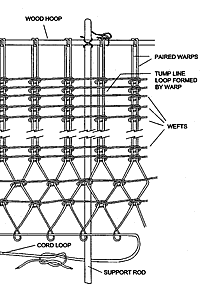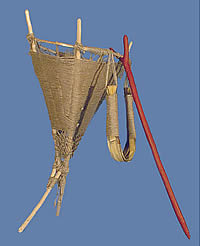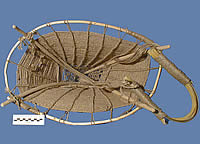
The smaller of the two carrying baskets "killed" over Burial 1 was used as a model
for the reconstruction. All of the cordage was dyed
red with ocher. The four support rods are missing.
Click images to enlarge
|

Schematic drawing of
the exterior surface of the weaver's
knot used to construct the netting.
|
|
Kiâhâs are cord-mesh
carrying baskets used throughout the Southwest.
The name 'kiâhâ' comes from the
Pima language. These baskets comprise a cord
netting supported by a hoop and four rods.
In order to better understand the construction
methods used to produce the kiâhâ
recovered from Granado Cave, a small carrying
basket was reconstructed using the methods
originally used to create those excavated
from the cave.
The kiâhâ is shown
in use with a forked helping stick. The helping
stick supports the kiâhâ while
on the ground and could have served as a digging
stick.
To make the reconstruction, the ends of two
cottonwood branches were lashed together to form an oval.
Four cottonwood support rods were also used. The two longest
rods were lashed to the rope and tied together where they
crossed at the base. Nineteen pairs of warps were used, along
with 96 weft rows. For the reconstruction, modern three-ply
jute cordage was used. The original basket was made from two-ply,
Z-twist narrow-leaf yucca cordage, and yucca or agave flower
stalk support rods.
The weaving method used to fabricate
the mesh cord netting in the Granado Cave
kiâhâs appears to be unique to
the Rustler Hills, and employs a distinctive
encircling of a weft cord around a warp cord.
This technique is sometimes described as "old
wrapped weaving," where the weft does
not twine or interlace through the warp, but
simply wraps around it. There are 19 pairs
of warps and 96 weft rows, including 5 loose
rows at the bottom of the basket. The reconstruction
uses the same number of warps and wefts as
the original basket.
|

The reconstruction was made of cottonwood
branches (two for the hoop and four for the support
rods), jute cord, and two broad-leaf yucca leaves for
the head band of the tump line.
|

Interior of the reconstructed basket
shows the distinctive construction weave. Note the tump
line is secured with four loops midway down
|
|